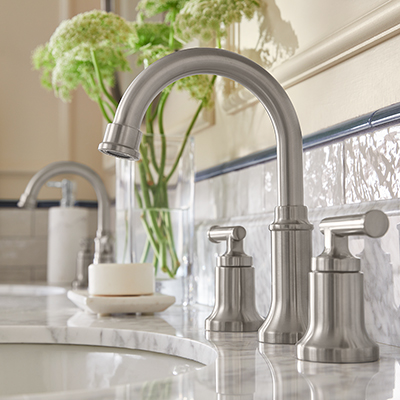How to Measure for a Bathroom Vanity

Last updated June 26, 2024
Bathroom vanities bring both function and beauty to your bathroom. The counter holds one or more sinks and faucets. Plus, you have cabinets for storage and to cover the plumbing. Selecting the right bathroom vanity starts with determining what will fit in your bathroom.
Whether you’re updating an existing bath or finishing a new one, there are various bathroom vanity sizes to choose from. Read this DIY bathroom measurement guide to learn how to measure for a bathroom vanity, bathroom vanity sizes and more.
Difficulty:
Beginner
Duration:
Under 2 hours
Table of Contents
Standard Bathroom Vanity Dimensions
Choosing the Right Height for Your Bathroom Vanity
Tools for Measuring a Bathroom Vanity
Measuring for a Replacement Bathroom Vanity
Measuring Single vs. Double Vanities
Avoid Common Vanity Measuring Mistakes
Standard Bathroom Vanity Dimensions

Standard bathroom vanity dimensions can vary depending on the type of vanity you choose. The most popular choices are bathroom vanities with tops. You can also choose a bathroom vanity without a top and get a bath vanity top separately. On average:
- Standard vanity widths are 24 inches, 30 inches, 36 inches, 48 inches, 60 inches and 72 inches. Most vanities are 24 to 60 inches wide.
- Standard vanity depth ranges from 14 to 26 inches deep, with an average around 21 inches.
- Most standard bathroom vanities measure 31 to 32 inches high.
In addition, the different bathroom vanity sizes can vary based on different styles. For example:
- Freestanding bathroom vanities that are popular and often found in small bathrooms.
- Floating bathroom vanities which hang on the wall for a modern feel.
- Corner bathroom vanities that utilize unused space in large or small bathrooms.
- Build-to-fit bathroom vanities which allow you to customize cabinets for your bathroom's style and layout.
Choosing the Right Height for Your Bathroom Vanity

One of the bath vanity dimensions that directly affects ease of use is height. When choosing the right height for your vanity, think about the overall layout of bathroom. If you have high ceilings, a taller vanity will create a balanced look. For a small bathroom, choose a lower vanity height to make the space look and feel more spacious. Also consider who will be using the vanity.
- For the average adult, the best standard vanity height is typically between 32 to 36 inches. This allows you to use the sink and countertop without straining your back.
- For disabled users such as those in a wheelchair, choose a vanity that's 29 to 34 inches to provide easy access to the sink.
- A vanity that's 36 inches or higher will be more comfortable for taller users.
- A good standard vanity height for shorter users such as children is typically around 30 inches.
Tools for Measuring a Bathroom Vanity

A tape measure is the primary tool you’ll need for an accurate measurement. Most contractors and DIY experts used a 25-foot cased tape measure. Keep your tape measure handy in your homeowner’s toolbox. You’ll also need paper and pencil to record the measurements or roughly draw the space you’re measuring.
Measuring for a Replacement Bathroom Vanity

Begin by clearing the space of any obstacles or clutter that will get in the way of an accurate measurement.
- Measure the height of the cabinet from the floor to the countertop, making note of the thickness of the countertop.
- Measure the width of the cabinet.
- Measure the depth of the cabinet.
- Record the measurements on paper.
Vanity counters can add up to an inch on either side of the cabinet. Be sure to add in this amount when measuring clearance from the walls and fixtures.
Tip: Roughly draw the bathroom space and make note of the toilet, shower, tub and any doors or windows.
Measuring Single vs. Double Vanities

- Single sink bathroom vanities are ideal for small spaces or guest bathrooms. Single sink vanities range from 24 to 48 inches wide. Double sink vanity sizes start at 48 inches and go up to 72 inches.
- Double sink vanities can resolve a lot of problems in a household. They offer extra counter and storage space and are ideal for spacious bathrooms.
Avoid Common Vanity Measuring Mistakes

When measuring for a bathroom vanity, make sure to avoid common errors. Make sure to:
- Consider the placement of plumbing fixtures. Pipes and drains can affect the placement, style and size of your vanity.
- Remember that a double vanity requires more plumbing allowance than a single vanity.
- Allow for how your bathroom door swings open. Factor in the distance from the wall to the edge of your bathroom door.
- Leave enough clearance space in front of the vanity to open any doors or move around freely.
- Add 4 inches of space on either side of the vanity to accommodate the countertop and other fixtures.
- When determining the standard vanity depth of your fixture, measure from the wall to the edge of any baseboard trim. That way your vanity will fit well against the wall.
- Always measure every measurement twice before purchasing your new vanity.
- If you're getting a bathroom vanity set, make sure to measure the space above your vanity for a proper fit.
Tip: Shorter vanities often work well for children. But, children often grow, and you may have a too-short vanity in a few years.
Getting the right measurements for the perfect vanity is essential for success. Knowing how to measure for a bathroom vanity is one of the easiest parts of a bathroom upgrade. Ready to get your new bath vanity? Use The Home Depot Mobile App to locate products and check inventory. We'll take you to the exact aisle and bay. If renovating a bath is a bigger project than you want to tackle, then let our professional bathroom remodeling services update your bath for you.



























